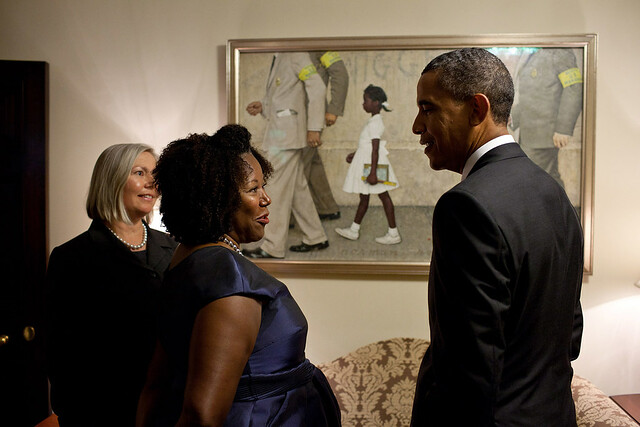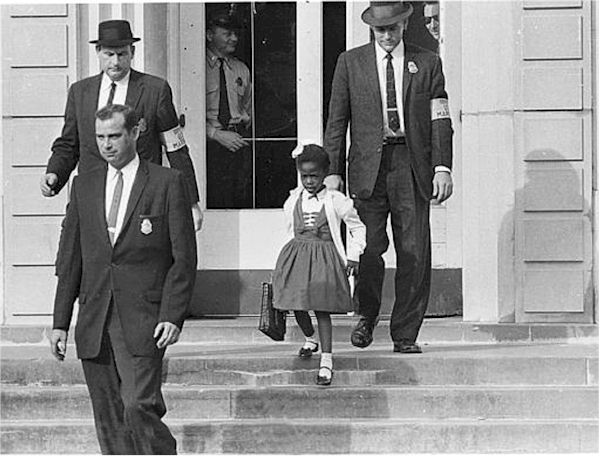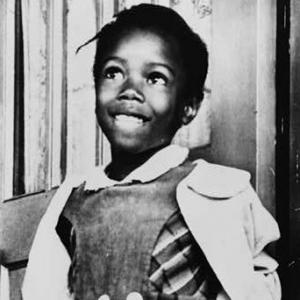By Marian Nimoh
Imagine being singled out at school or in class because no one – including teachers and students- wants to work with you because of the color of your skin. Imagine having a bodyguard follow you everywhere you go, due to other peoples threats because they see the greatness, power, and person you can become. Some become discouraged, others find the strength to become courageous and not let the threats faze them. This is the story of Ruby Bridges, a civil rights activist in New Orleans.
Ruby Bridges was born on September 8, 1954, in Mississippi, the same year that the Supreme Court desegrated schools. Her father worked at a gas station while her mother worked night jobs to provide for the family.
When she was six years old she passed the exam to enter William Frantz, a white elementary school. The exam was created to be extremely difficult to stop black children from going to white schools. Though she was admitted to the school she did not attend immediately due to disputes on whether schools should be integrated. She had to wait a year to as she was the first black person to pass the exam and would possibly be the first black person to enter a school reserved for white students.
Being one of the first black students to integrate school was not easy. Her father lost his job and her grandparents lost the farm they owned. Every day, before entering the school building, protestors wished death upon her. One protester told her that she would poison her food forcing Bridges to bring food from home to eat at school and on her second day of school, a protester drew a picture of Bridges in a coffin and greeted her before entering the school building. She always had four U.S. federal marshals and her mother escort her to school.
“There was a knock at my door, my parents opened the door and four very tall white men were standing at the door. I remember thinking ‘who are they?’” Bridges said of the U.S. marshals in a 2017 interview with ‘The 700 Club’.
Parents had threatened to remove their children from Bridges’ class and possibly the school if she was admitted, which they ultimately did once she began school. Even teachers did not want to teach Bridges, except for Mrs. Barbara Henry, who agreed to teach Bridges. For a year, she was the only student in Mrs. Henry’s class, who planned Bridges’ lessons and helped her cope with what was happening. She was not safe to go to the bathroom by herself and always had to have the marshals by her side. Kids did not want to eat or play with her during lunch so she always ate by herself. It got to a point where Bridges was fed up of having to eat her lunch by herself that she started hiding her lunch in the school cabinet. After mice were found in the classroom, her teacher Mrs. Henry began sitting with her to eat lunch.
“I remember going to the back of the classroom to sharpen my pencil and you could look to the playground. There were these huge oak trees, swings and slides and I was thinking as I sharpen my pencil, where are the other kids?” Bridges said, “I finally found them and I was so excited so I went in to play with them and this little boy looked at me and said, “I can’t play with you, my mom said not to play with you because you’re a nigger.”
Through prayers and her mother, Bridges found her strength and courage to keep going to school and various people in the community began to help the family, whether through babysitting or even walking behind the marshals to school. During her first year, Dr. Robert Coles a child psychologist volunteered to provide counseling for Bridges as he was concerned about how she would handle the pressure.
Towards the second year of her attendance at Frantz elementary school, the chaos began to subside. Bridges started walking to school by herself and kids were slowly attending the same class that she was in, even though some did not want to be her friend because of her skin color. At first, Bridges had not understood the extent of the racism that had been displayed because of her going to school. She only began to understand it when other students did not want to befriend her.

Obama White House / Flickr – Ruby Bridges and Obama
Bridges later graduated from the Francis T. Nicholls High School in New Orleans and studied travel and tourism business at the Kansas City School of Business, before working as a travel agent for American Express. She married Malcolm Hall and had four children and became a full-time parent.
In 1993, her youngest brother, Malcolm Bridges, was gunned down and she created the Bridges foundation to honor her brother and help herself get a better understanding of her situation when she attended elementary school. She began to care for her brother’s four children and they also attended the William Frantz elementary school. She became a parent-community liaison and volunteered at the school. Her foundation promotes tolerance and respect as well as acceptance of diversity. It also encourages parents to get involved in their children’s education.
Her courage and strength as a young girl have been honored in different ways across the country. The children’s museum of Indianapolis has an exhibition of Bridges’ life. In 1998, a Disney movie was made about her being the first black child to integrate an all-white elementary school in the South. She was reunited with Mrs. Henry on the Oprah Winfrey show and in 1995, Dr.Coles published ‘The story of Ruby Bridges,’ a children’s book that portrayed Bridges courage. Artist Norman Rockwell painted Bridges’ first day of school which portrayed her being escorted by four white men and titled it ‘The Problem We All Live With’. In 2011, Obama asked for the painting -which was in the Norman Rockwell Museum in Stockbridge, Maryland – to be loaned for four months to the white house. The painting was posted in the West Wing of the White House.





